The war in Ukraine is ongoing creating mayhem in the markets, fuelling oil’s prices to levels not seen for more than 10 years. We expect the issue to remain one of the main if not the main fundamental issue among traders in the coming week as well. On the monetary front we would highlight the interest rate decision of the ECB on Thursday, which may find itself in a difficult spot right now, while policymakers from other central banks around the world may also sway the market mood in the coming days.
As for financial releases we expect a lighter calendar, yet there are still a number of high impact data to be released that could shake the markets. We note on Monday the release of China’s trade data for February and on Tuesday the release of Eurozone’s revised GDP rate for Q4 2021. On Wednesday we get the revised GDP rate of Japan for Q4 2021 and on Thursday we get the US CPI rates for February. On Friday we highlight UK’s GDP and manufacturing output growth rates for January as well as Canada’s employment data for February.
USD – US February CPI rates provide clues about the Fed’s intentions
The USD continued to be on the rise for a fifth consecutive week, yet we must note that the US employment report for February is still to be released and under certain circumstances may alter the direction of the USD. Overall, the war in Ukraine seems to worry not only traders but the general public in the US. It was characteristic that President Biden in his State of the Union speech on Tuesday showed the US solidarity to Ukraine and even got personal against Russian President Putin. Overall, the speech demonstrated the decisiveness of the US to confront, not directly but still, Russia. Note that he stated clearly that the US “will not engage in conflict with Russian forces in Ukraine”.
Despite the speech being dominated by the war in Ukraine, the President also vowed to curb inflationary pressures back home by a master plan including cutting the price of prescription drugs, reducing energy costs for families and others while also stated that his plan to fight inflation “will lower your costs and lower the deficit.”. The same worries about inflation also tended to dominate Fed Chairman Jerome Powell’s testimony before the US Congress on Wednesday and Thursday. The Fed Chairman stated that inflation increased sharply in the last year and is currently running well above the bank’s longer run objective of 2%. The Fed Chairman in his statement mentioned that it would be appropriate to hike rates, yet avoided any hints towards a 50 basis points rate hike in March, nor did he commit to any particular rate hike path, allowing for some flexibility.
As for financial releases, we highlight the release of the US CPI rates for February on Thursday. The release along with the accelerating Core PCE price index and February’s employment report that is due out today, could have a substantial bearing on the Fed’s interest decision. It was characteristic that Fed Board Governor Waller stated that “if, for example, tomorrow’s PCE inflation report for January, and
jobs and CPI reports for February indicate that the economy is still running exceedingly hot, a strong case can be made for a 50-basis-point hike in March”. We would also like to note the release of the weekly initial jobless claims figure on Thursday while on Friday we get the preliminary University of Michigan consumer sentiment for March.
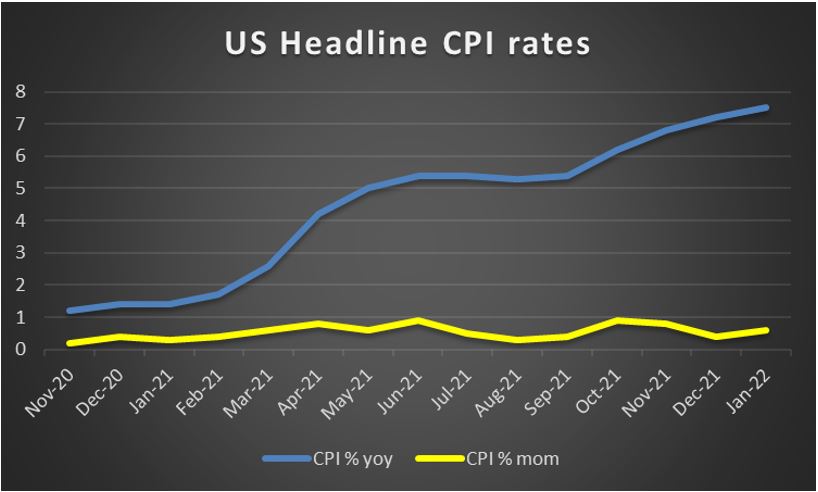
GBP – GDP rates at the end of the week awaited
The pound seems to be on the retreat against the USD and the JPY in a similar movement for the week but not against the EUR. On the fundamental side the UK government seems to be experiencing a “rally around the flag” effect at a milder form as the rhetoric seems to be shifting increasingly towards the support of Ukraine, after the Russian invasion. The situation may allow for the UK PM Johnson to slip out of the difficult spot he was in about “party-gate” in the previous weeks. Nevertheless, the UK PM also made clear that UK will not be fighting the Russians in Ukraine as he stated that “I want to be crystal clear finally on that point, we will not fight Russian forces in Ukraine”.
Also UK PM Johnson highlighted the possibility of an energy price shock after the announcement of the most recent sanctions against Russia. On a more positive note, BoE has said that exposures of banks to Russia are relatively low, which lowers the overall risk factor for the UK economy from the Ukrainian crisis. It should be noted that besides a jump in gas and electricity bills, also fuel prices have gone up in the UK. Overall the inflationary pressures in the UK economy are still high and we may see the BoE taking a more hawkish stance to confront the issue.
Definitely the market’s expectations are hawkish and its characteristic that the market seems to be currently pricing in fully a rate hike in its March meeting, while another two are partially priced in at the moment, according to GBP OIS. As for financial releases for pound traders we note on Monday the release of the Halifax House Prices for February, while on Friday we note the release of the GDP rates for January as well as the manufacturing output growth rates for the same month.
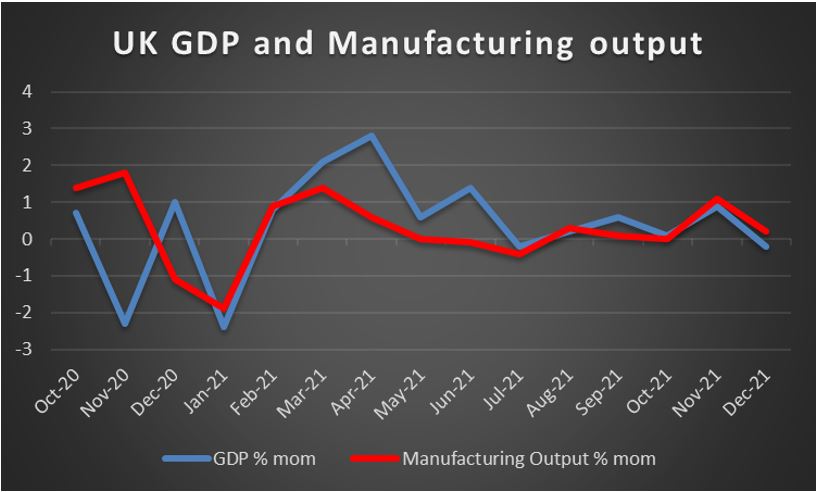
JPY – Safe haven flows to continue to be the driver for JPY
JPY seems to be losing ground against the USD as the greenback seems able to attract more safe haven inflows, yet gains considerably against the common currency and the sterling for a second week in a row. On JPY’s fundamentals we note that Japan seems to be hardening its determination against Russia yet the whole situation may have a hidden cost for Japan , namely the Kurill islands in the north, which Japan is claiming. At the same time recent calls within Japan by former Prime Minister Shinzo Abe towards the Japanese government to consider hosting US nuclear weapons seem to have created tensions with China, yet definitely could create frictions also with Russia, given Mr. Abe’s influence. Also it should be noted that Japan joined other western powers by imposing sanctions on Russia and limiting the transactions with it, according to Japans’ Prime Minister Kishida, as Japan would stand by the side of Ukraine.
On the pandemic front we must note that Japan will ease its border controls further, yet seems about to extend Covid restrictions in some areas. On the monetary front we note that BoJ’s approach and its ultra loose monetary policy, seems to remain untouched. On the other hand, we must note that the Japanese Government announced nominees to replace two central bank policymakers which are to leave the bank in the summer and the appointments may tilt the balance of power in the BoJ towards a less dovish approach, according to Reuters, yet that is still a long way off.
Despite our base scenario being for JPY to continue to be affected primarily by safe haven flows in the coming week due to the war in Ukraine and its dual nature, nevertheless we would still like to note a couple of financial releases in the coming week. On Tuesday’s Asian session, we get the current account balance for January while on Wendesday we get the revised GDP rate for Q4 2021. On Thursday we get Japan’s Corporate Goods Prices for February and finally on Friday we get from Japan the All household spending growth rate for January.
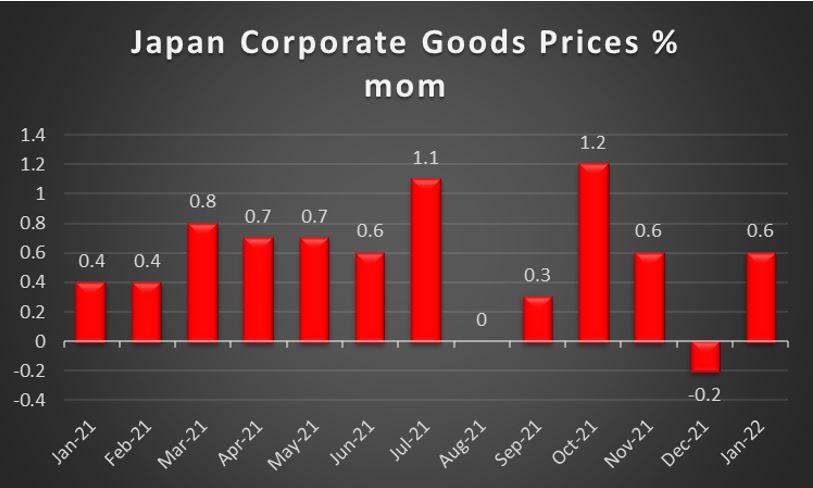
EUR – ECB’s interest rate decision in focus
The common currency is tumbling against the USD, surpassing a twenty one month low and is also weakening against the JPY and the GBP, in an additional signal of the common currency’s weakness. The war in Ukraine fundamentally weighs on the common currency given that sanctions on Russia seem to be biting back, as they create substantial uncertainty for the growth of the area’s economy. The rise of oil and natural gas prices, along with the expected rise in the price of grain and a number of raw materials that used to be imported by Russia and Ukraine is a big issue, as is a possible disruption of supply chains. In addition to all of that the EU will have to face the uncertainty created at it’s south eastern borders along with the humanitarian crisis that is expected to follow. Also, please note that a particular worry for EUR traders could be the exposure of European banks to the Russian economy.
Banks in a number of countries such as France and Italy have a substantial exposure in Russia and we would also like to note Austria as a possible risk factor. The main event for EUR traders next week though is expected on the monetary front, as we get ECB’s interest rate decision. The Bank is widely expected to remain on hold, keeping the refinancing rate at 0.0% and the deposit rate at -0.50%, with EUR OIS implying currently that a probability of 92% for such a scenario to materialise exists.
The main attention of market participants though is expected to be placed on the forward guidance of the bank. It should be noted that inflationary pressures in the area are accelerating, at least according to Eurozone’s preliminary HICP rates for February and is calling on the ECB to act and tighten its loose monetary policy . On the other hand, given the war in Ukraine, the European economy may need all the help it can get on a monetary level. Our base scenario remains that the bank’s balance of power would tilt in keeping favourable financing conditions in the Eurozone and thus we may expect the bank to sound dovish in its accompanying statement and ECB President Christine Lagarde’s following press conference.
Any voices for a tightening of the bank’s monetary policy that were heard in the past few months may be silenced for now and a possible dovish tone could weaken the EUR. As for financial releases, the calendar is rather light for EUR traders, nevertheless we would like to note the release of Germany’s industrial orders growth rate for January on Monday while on Tuesday we get its sister indicator, namely Germany’s industrial output growth rate for the same month. On Tuesday we also highlight the release of Eurozone’s revised GDP rate for Q4 2021, while on Friday we get Germany’s final HICP rate for February.
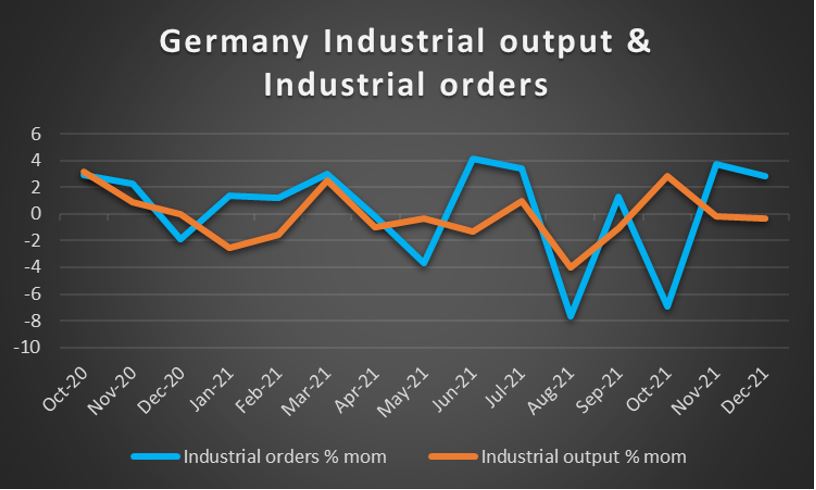
AUD – AUD supported by higher commodities prices
AUD seems to be in the greens against the USD for a fifth consecutive week. This week AUD/USD has performed the widest weekly rise considering the past several months. The crisis in Ukraine in conjunction with the gradual recovery of economic activity in the manufacturing sector at a global level, have supported the price of raw materials as shortages were created and thus supported the Aussie. As reported by Reuters, prices of coal, one of the main products exported by Australia, rose between 25-50% as buyers were trying to replace supplies from Russia.
Also iron ore prices as well as LNG and aluminium prices were on the rise supporting Australia’s international trading activities, raising the trade balance to AU$12.9 billion, a figure that far exceeded the market’s expectations for January. In the coming week we expect China’s trade data for February to be closely watched by Aussie traders as China is one of the main, if not the main trading partner of Australia. Should China’s import growth rate be on the rise, that could be a prelude for further exports of Australian products to the Chinese mainland and thus provide support for the AUD and vice versa.
Beyond that we would also note the release of China’s inflation metrics for February on Wednesday, while on Tuesday we get from Australia the consumer sentiment for March and the NAB Business Conditions and Confidence indicators for February. On a monetary level, we cannot pass out on RBA’s interest rate decision last Tuesday. The bank as was widely expected remained on hold keeping the cash rate target at 0.10%.
In RBA Governor Lowe’s accompanying statement the bank stated that “There are uncertainties about how persistent the pick-up in inflation will be given recent developments in global energy markets and ongoing supply-side problems”. The statement highlighted the possibility of the acceleration of the inflation rates being temporary or not sustainable which could be considered as dovish. We note the planned speech of RBA Governor Philip Lowe on Wednesday and intend to monitor it for any clues regarding RBA’s further intentions.

CAD – Employment data eyed by CAD traders
The CAD is in the greens against the USD for a second week in a row, maybe also supported by the rise in oil prices. It should be noted that the threat of a tighter oil market due to the disruption of oil supply because of the war in Ukraine supported oil prices. It was characteritic how the US oil market reported drawdown in their weekly stock figures by both API and EIA which took markets by surprise. Even the announcement on Tuesday of an agreement for a coordinated deployment of 60 million barrels by the International Energy Agency’s countries was not able to put a lid on oil’s prices, allowing for WTI to peak at almost $115 per barrel on Thursday, thus reaching a 14 year high.
On the other hand we must note a wide downward correction in oil prices occered in the American session on Thursday, which underscored the volatility reflected by the uncertainty in the oil market. Negotiations between Iran and the US to reach a new nuclear deal seem to near their completion and a positive outcome is on the horizon yet is still highly uncertain. Even should the two parties reach an agrement and Iran is to reenter as a major oil supplier the international markets, it may not be able to fill the gap created by a possible lack of Russian oil supplies. Please note that US lawmakers are about to introduce a ban on the imports of Russian energy products.
On the monetary front we would also like to mention BoC’s interest rate decision. The bank as was widely expected hiked rates by 25 basis points and in its accompanying statement, BoC sounded confident and determined to curb inflationary pressures in the Canadian economy and expressed a willingness to hike rates further towards that end. It should be noted that BoC Governor Tiff Macklem verified the bank’s hawkish intentions in his speech on Thursday. As for financial releases we note the release of Canada’s trade data for January on Tuesday and highlight the release of February’s employment data on Friday.
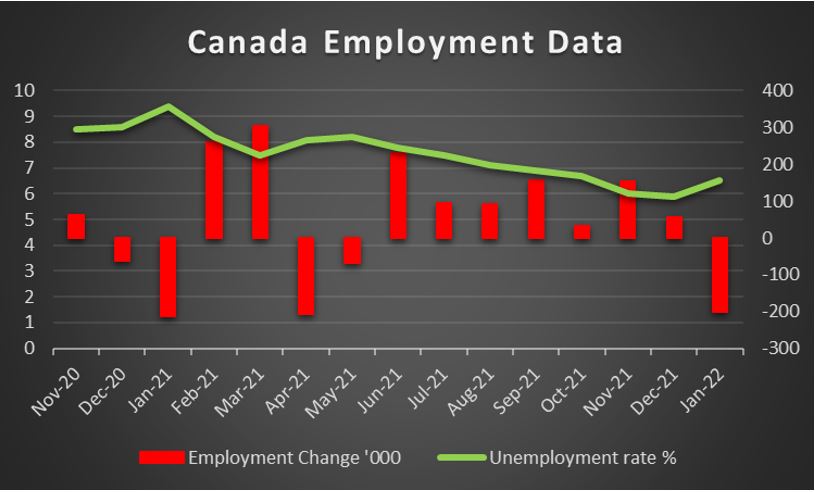
General Comment
The war in Ukraine continues to rage and the humanitarian crisis is ongoing and could magnify in the coming days. Military operations are ongoing and could intensify the market’s worries. Also, Russians seem to be fixed capturing on Kyiv and should Russian troops actually enter the Ukrainian capital, casualties could rise to very high levels. On the other hand, the Russian economy is suffering from the sanctions imposed by western powers. Up until now Russians were on the defensive as they try to ease the blow on their own economy, yet the possibility of retaliatory sanctions by Russia cannot be excluded.
The Russian Central Bank has ordered a bundle of measures to prevent the bank run, from more than doubling the key interest rate to 20% as well as an emergency move to freezing local equity trading since Friday. Russia has also temporarily banned foreigners from divesting Russian assets and ordered exporters to sell 80% of their foreign currency earnings. In the FX market it’s expected to be a week ahead with a lighter calendar allowing somewhat for fundamentals to increase their influence over the market. The USD is expected to maintain the initiative over other currencies yet still at certain moments during the week other currencies may steal the spotlight from the greenback thus creating diverse trading opportunities.
If you have any general queries or comments relating to this article please send an email directly to our Research team at research_team@ironfx.com
إخلاء المسؤولية:
لا تُعد هذه المعلومات نصيحة استثمارية أو توصية بالاستثمار، وإنما تُعد تواصلاً تسويقيًا. لا تتحمل IronFX أي مسؤولية عن أي بيانات أو معلومات مقدمة من أطراف ثالثة تم الإشارة إليها أو الارتباط بها في هذا التواصل.













